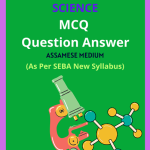Class 8 Science MCQ Chapter 17 Stars and The Solar System Solutions in English Medium, Class 8 Science Multiple Choice Question Answer in English to each chapter is provided in the list so that you can easily browse throughout different chapters Class 8 Science MCQ Chapter 17 Stars and The Solar System Notes and select need one.
Class 8 Science MCQ Chapter 17 Stars and The Solar System
Also, you can read the SCERT book online in these sections Class 8 Science Objective Type Solutions by Expert Teachers as per SCERT (CBSE) Book guidelines. These solutions are part of SCERT All Subject Solutions. Here we have given Assam Class 8 Science MCQs Solutions in English for All Subject, You can practice these here.
Stars and The Solar System
Chapter – 17
| MCQ |
1. Which is the brightest planet in the universe?
(a) Mercury.
(b) Venus.
(c) Earth.
(d) Saturn.
Ans: (b) Venus.
2. Which is the nearest planet to the sun?
(a) Neptune.
(b) Mars.
(c) Mercury.
(d) Earth.
Ans: (c) Mercury.
3. On which planet the life exists?
(a) Earth.
(b) Moon.
(c) Jupiter.
(d) None.
Ans: (a) Earth.
4. Which planet appears to be yellowish?
(a) Asteroids.
(b) Mars.
(c) Uranus.
(d) Saturn.
Ans: (d) Saturn.
5. Farthest planet of the solar system is:
(a) Neptune.
(b) Jupiter.
(c) Mercury.
(d) Earth.
Ans: (a) Neptune.
6. Sky is not clear in cities due to:
(a) Dust and smoke.
(b) More population.
(c) Bright light.
(d) Larger area.
Ans: (a) Dust and smoke.
7. The celestial body nearest to the earth is:
(a) Venus.
(b) The Sun.
(c) Proxima.
(d) The moon.
Ans: (d) The moon.
8. Of which element is ozone made?
(a) Oxygen.
(b) Nitrogen.
(c) Carbon.
(d) Carbon and oxygen.
Ans: (a) Oxygen.
9. Neptune have very low temperature due to:
(a) Far distance from sun.
(b) Presence of oxygen.
(c) Huge amount of ice.
(d) Glacier on its surface.
Ans: (a) Far distance from sun.
10. Star appear small because.
(a) They are very far.
(b) They have dim light.
(c) They are smaller than moon.
(d) They reflect the Sun.
Ans: (a) They are very far.
11. Which of the following is the brightest non-star visible to the human eye?
(a) Moon.
(b) Venus.
(c) Mars.
(d) Jupiter.
Ans: (a) Moon.
12. Which planet has the most moons?
(a) Mars.
(b) Earth.
(c) Saturn.
(d) Uranus.
Ans: (c) Saturn.
13. What is the name of the force that keeps planets in orbit around the Sun?
(a) Electromagnetic Force.
(b) Gravitational Force.
(c) Nuclear Force.
(d) Frictional Force.
Ans: (b) Gravitational Force.
14. Which planet is known for its Great Red Spot, a giant storm?
(a) Uranus.
(b) Jupiter.
(c) Saturn.
(d) Neptune.
Ans: (b) Jupiter.
15. What is the term for a small rocky body that orbits the Sun, mostly found between Mars and Jupiter?
(a) Comet.
(b) Asteroid.
(c) Meteor.
(d) Dwarf Planet.
Ans: (b) Asteroid.

Hi! my Name is Parimal Roy. I have completed my Bachelor’s degree in Philosophy (B.A.) from Silapathar General College. Currently, I am working as an HR Manager at Dev Library. It is a website that provides study materials for students from Class 3 to 12, including SCERT and NCERT notes. It also offers resources for BA, B.Com, B.Sc, and Computer Science, along with postgraduate notes. Besides study materials, the website has novels, eBooks, health and finance articles, biographies, quotes, and more.




